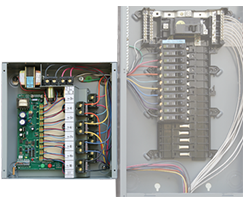 Gallery art is made to be viewed, which means it’s also meant to be properly lit. Lighting design can make or break a gallery, casing light and shadow in a way that can highlight or diminish the pieces accordingly. Furthermore, every piece in the gallery is presumably unique, requiring flexibility and customization where necessary. When you’re working with this much lighting, it’s equally important to find centralized lighting control that can handle it without requiring extensive amounts of time to turn on and off every day.
Gallery art is made to be viewed, which means it’s also meant to be properly lit. Lighting design can make or break a gallery, casing light and shadow in a way that can highlight or diminish the pieces accordingly. Furthermore, every piece in the gallery is presumably unique, requiring flexibility and customization where necessary. When you’re working with this much lighting, it’s equally important to find centralized lighting control that can handle it without requiring extensive amounts of time to turn on and off every day.
For energy efficiency and low heat emission, many modern lighting control designers prefer LEDs for art galleries, and this was certainly true of the designer who did the lighting for the recent opening of the Dr. Clotilde P. Garcia Spanish Colonial Gallery, a new permanent addition to the Art Museum of South Texas in Corpus Christi. The dramatic pieces on display required equally dramatic lighting, and lighting designer Jerry Colmenero did the job justice. During the planning, however, he knew he’d need a solution to create a self-sustaining lighting system that could automate the process while extending the LEDs life for as long as possible. He was looking for something energy-efficient and relay-based.
Naturally, he landed on LynTec’s Lighting Control Relay Panel.
Our LCRP differs from more traditional relay-based panels by taking up less space and offering a greatly simplified installation and setup process. The panel, which comes with space for 4, 8, or 10 relays, can be set up quickly by a licensed electrician and placed anywhere between the circuit breaker panel and the lighting equipment. DMX controlled and non-controlled circuits can be mixed on the same panel, allowing a high level of customization and flexibility.
LynTec’s LCRP can house up to ten circuits, giving the gallery plenty of room for future growth. In the meantime, the four active circuits on the panel can be automated or directly controlled by a simple on-off operator switch to greatly streamline the design. Different modes make it easy to bring up lighting for maintenance only, while the art lighting can be managed separately. This particular system features the ability to control individual lights via a mobile device, giving tour guides the ability to highlight specific pieces and dim the light on others. In addition, a second LynTec panel can be found in the museum’s children’s black box theater powering the color-changing LED stage lighting.
As Colmenero says, “LynTec is the core of what makes these designs work.” Centralized lighting control offers extensive benefits and a flexible system offers a world of opportunities for design. We’re proud to be counted as part of this project.







Add Comment